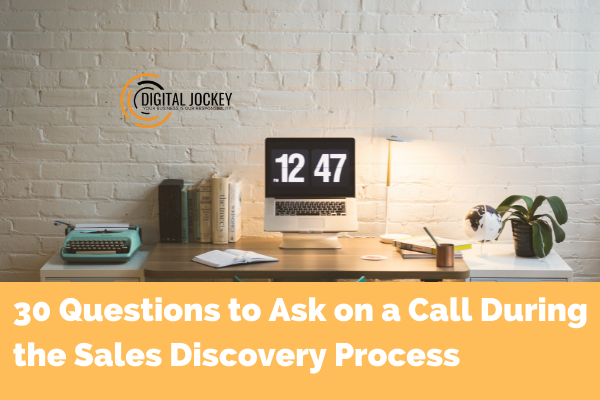30 Questions to Ask on a Call During the Sales Discovery Process
The discovery call is the most vital phase in any B2B sales process. It’s the first call that marketers have to make after getting in touch with a prospect via email. During these calls, marketers need to determine if their products/services and their prospects match by asking the prospects a series of questions that unearth their requirements, problems, and objectives.
For this initial step in the sales qualification process to be successful, buyers and sellers need to have collaborative conversations. Each party can benefit from building better rapport and engaging in value-driven dialogue. To create more trust with the potential buyer, the seller must share relevant insights and probe the buyer’s issues in a way that builds a strong case in favor of the purchase.
“How to Ask Effective Questions During the Sales Discovery Process?” Here’s a list of 30 questions that top sales professionals use during the discovery phase to uncover the maximum amount of information they need to generate leads. We’ve divided these ‘conversation sparking’ questions into four categories –
- Introductory questions.
- Questions that qualify the prospect.
- Questions that disqualify the prospect.
- Questions that guide potential buyers to taking the next steps.
Before getting started with these questions, sales professionals must –
- Thoroughly research the target buyer.
- Practice active listening.
- Learn how to use high-impact questions that encourage target buyers to speak more.
Bear in mind – the point of sales discovery calls is to learn as much as possible about the customers. The following 30 questions will help sales professionals spark conversations, create trust, and guide potential buyers towards taking conclusive steps.
1. Introductory Questions
These are the questions that help sales professionals learn more about the target customers’ specific situations. Sales professionals may already know some answers to these questions beforehand (via their research).
So, these questions give them a chance to validate their research, understand how things work internally (at their company), and gain the insight they need to push on deeper into the sales process.
Q1. Would you mind describing your company and what it does?
Ask this question after introducing yourself. Don’t make it seem as if you haven’t done any prior research. Clarify the details you already know and gently ask them to build upon your account of their company.
Q2. What is your role in the organization?
This slightly more personal question is directed to the employee on the other line, not the company itself. Don’t draw out this question. Ask this casually to build rapport with the employee.
Q3. What are your organizational responsibilities?
This question is slightly less casual. It aims to quantifiably confirm whether your product/service can help the responder be better at their job. Uncover this information to get a sense of how your product can help the company’s and the employer’s goals.
2. Questions that Qualify the Prospect
Once the introductory phase is complete, it’s time to discover what problems your products/services can solve for the prospect.
Q4. What are the key financial and operational goals of the organization within a specific time period?
It’s time to get into the specifics. Choose a timeline and ask about what goals the company aims to meet during this timeline. For instance, if you’re selling a security tool that gives a healthy ROI within the next three months, ask about the company’s half-yearly goals.
Q5. Do you have products or services in place that help you achieve these goals?
This question should uncover whether they have proper plans in place to meet their organizational goals. If they already have similar tools or services that you’re offering, start preparing some points (in your mind) that position your product/service over the tools they’re already using.
Q6. What additional tools do you need to achieve company goals?
How urgently does the company need better tools or services to meet its short and long-term objectives? The answers to this question will help sales professionals determine whether the prospect is a “good fit.”
Q7. What are some obstacles your company is facing while attempting to meet its goals?
Allow the customer to bring up any issues their company may be facing. Use this query to learn more about their business challenges.
Q8. Can these obstacles be resolved with your product or service?
Don’t ask this question directly. Instead, keep the flow of the conversation open-ended. Allow the responder to drive the conversation toward a specific area of the business that your product or service can enhance.
Q9. Why is your company facing these obstacles?
Dig deeper by asking this question to uncover specific pain points that the prospect is distressed about resolving. Once you discover the sources of your prospect’s problem, creating a value-based sales pitch will become much easier.
Q10. Why is removing these obstacles an organizational priority?
This is a continuation of the previous question. Knowing how urgent this issue is for the prospect will help sales professionals draft better pitches later on in the conversation.
Q11. Why are these problems still unaddressed?
Has the target client tried removing these obstacles before? If so, why have they failed? For example, many businesses don’t have the budget to remove organizational roadblocks. In such scenarios, sales professionals can use the answer to this question to qualify/disqualify the target client instantly.
Q12. What is their dream solution to this problem?
Let the target client discover their ideal scenario. Even if their ideal solution doesn’t involve your product/service, use this question to learn how the prospect’s mind works when it comes to resolving important business issues.
Q13. What do you expect from a solution?
Discover whether your products/services can meet their ideal, long-term expectations. This set of questions will ultimately confirm whether this call will actually lead to something fruitful. Listen without motives or judgment. Then, move on to the next set of questions.
3. Questions that Disqualify the Prospect
Be it budget or time constraints – learn about all the factors that may disqualify the prospect from your sales goals.
Q14. What’s stopping you from implementing a solution for your business problem?
You’ve already asked about the roadblocks the prospect’s company is facing. Double down on this question to get very specific answers.
Q15. What would be the ideal time to implement a solution?
Does your product’s implementation schedule match the prospect’s time constraints? If not, you and your prospect’s business goals may not align. For example, if you’re selling a sales tool to a company that’s only focused on market research for the foreseeable future, they’re not a good fit for your product.
Q16. Does your company have the budget to solve this issue?
Start talking budget. Does the prospect have enough funding to invest in your project?
Q17. Who is in charge of your company’s spending?
Learn who or what funds the company’s annual or monthly budgets. Is it a single person (e.g., a sponsor) or the whole department?
Q18. Who are the prospect company’s main funding managers?
Be it a senior-level employee or a C-suite executive – it’s important to learn more about the people behind the organization’s budget.
4. Questions That Guide Potential Buyers to Taking the Next Steps
Once you’ve qualified/disqualified a prospect, it’s time to move them along the sales pipeline. This stage of questioning should be purely focused on providing solutions, explaining why your product is of value, and offering the steps that enable them to finalize the purchase.
Q19. What are your criteria for choosing vendors?
Learn what criteria you have to meet to take the call to senior executives.
Q20. Have you worked with similar vendors before?
Irrespective of the answer, establish a competitive advantage by describing why your products/services are better.
Q21. Is there someone else you’re considering purchasing a solution from?
Don’t sound judgmental or defensive – just learn who your competition is.
Q22. Who makes the decision to choose vendors for the company?
Learn about the gatekeepers of the organization. Learn how involved each senior figure of the company is in the decision-making process.
Q23. Who creates the criteria for vendors?
Learn what factors shaped their attitude towards working with specific vendors.
Q24. If you purchase our products/services now, what procedure will you have to follow?
Learn about the prospect’s typical purchasing processes to identify potential roadblocks that may pop up later on in the deal.
Q25. Have similar deals been halted before by roadblocks?
Understand whether any unexpected changes that may damage the deal in the future.
Q26. How can I prevent the deal from coming to a halt?
Be it additional resources about the product or citations from previous clients – clarify the steps you can take to ensure the deal is not halted in the future.
Q27. How will this solution make the responder’s job easier?
This is a rapport-building question that will make the conversation with the responder a lot easier.
Q28. How will this solution help the company?
Ask the responder to envision a typical day at the company after they’ve purchased your product/service. These are the details the responder will use to present your solution to the company’s chief decision-makers.
Q29. What does the company’s long-term future look like with our solution?
More customers? Better customer service? More brand awareness? Detail the ways in which your solution will enhance the company.
Q30. When should I follow up?
Close the call by scheduling another call to smooth over any remaining details.
Measured and well-thought-out sales discovery calls can help sales professionals understand important details about their prospects’ situations. With these calls, sales professionals can –
- Ensure prospects understand the products/services they’re offering. Prospects can receive answers about specific product features that gauge their interest in the deal.
- Sales professionals can give the impression that they understand the prospect’s problems. Successful sales discovery calls aren’t focused on getting the clients’ money – they aim to prove that the seller is invested in the buyer’s commercial objectives.
- Most importantly, discovery calls give sales professionals the chance to ‘qualify’ each potential client. Sales pros can tell from the prospect’s attitude towards the call whether they’re interested in purchasing the product/service they’re offering.
The list of benefits goes on. Optimizing these benefits will become much easier for sales professionals if they follow this 30-step template.


